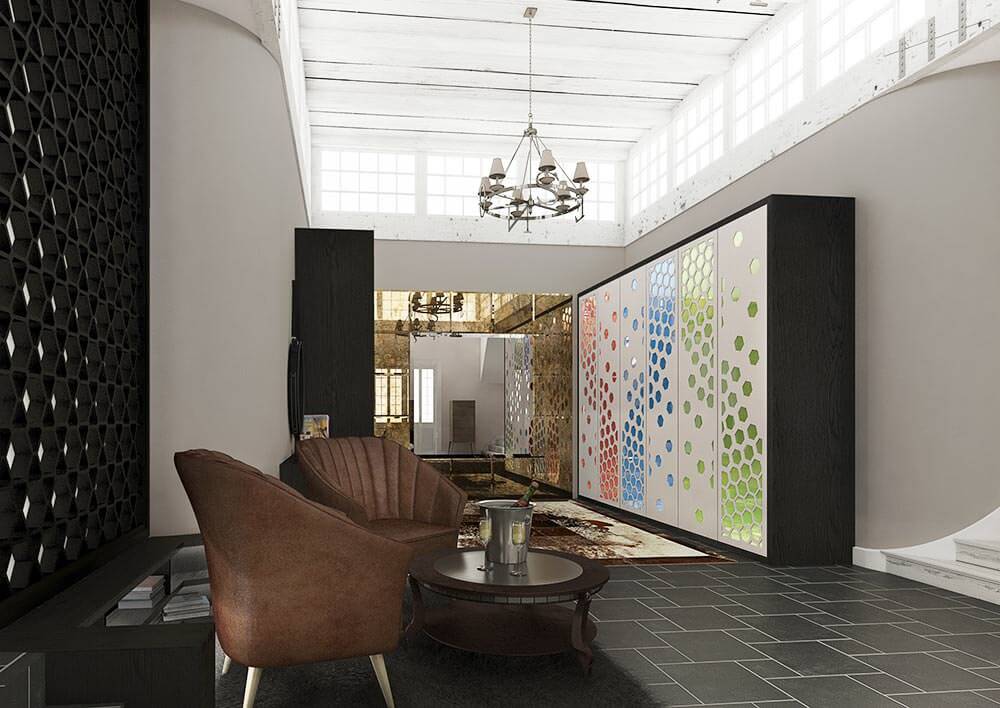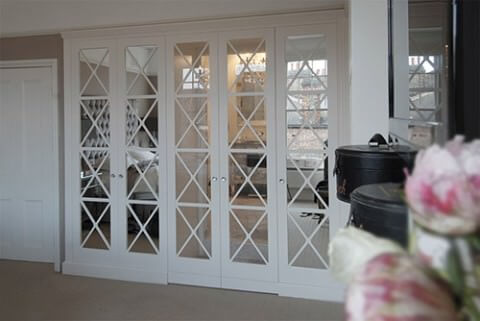
To create the perfect piece of furniture our experts combine a creative eye with a disciplined attitude to construction and respect for the materials we use. Before undertaking any project, we have to consider how the design, materials and methods of construction directly affects the functionality, longevity and aesthetic for every furniture piece.
The team at Inteka comprises expert craftsmen, who have each undertaken years of study to master their skills, allowing them to produce remarkable and functional pieces and built our reputation as market leaders in producing fine, bespoke furniture.
THE PREPARATION
Rest assured that if you choose to work with Inteka, you’ll receive a fully bespoke service and a completely unique piece. Each piece of furniture that we produce is engineered to exact specifications and tailor-made to ensure it fits perfectly into your home and meets your requirements.
We spent a significant amount of time considering every aspect of the furniture to ensure it is perfect, with just a few of such elements detailed below:
- Design vs strength and rigidity to wear.
- Methods of construction vs selected materials and finish as well as designated use.
- Ways of assembly on site vs available access and space.
Once this is complete we work out a complete inventory necessary to produce the project. Materials are sourced and delivered to our workshop where our craftsmen carry out further preparatory steps.
THE WORKSHOP
All the practical procedures (cutting, drilling and sawing) take place in our workshop, which is fully equipped with latest technology to produce fine bespoke furniture pieces. By now the project is fully documented and presented to the team of craftsmen in the workshop who are briefed on the project specifics.
The workshop team cut all materials to size, mark and pre-drill individual parts to prepare it for on-site installation. Drawers, pull-out shelves, doors, internal lighting and many other things are produced and positioned at this stage. Smaller units that can be safely transported and brought on site in one piece are also assembled.
This is where the foundations of your bespoke piece are put into place and our skilled carpenters make sure that it is all done to very high standards.
CONTINUE TO...
At Inteka, we understand that your home should be your haven, away from the stresses of work and a space for you to relax and spend time with friends and family. We also know that having any type of building work done at home can be a taxing, so our expert installations teams aim to minimise the disruption during this process.
We invite you to browse our gallery to see our portfolio of custom-made and fitted furniture.
Fitted bedrooms • Bespoke wardrobes • Walk-in wardrobes • Custom made cupboards • Made to measure shelves • Custom-built libraries • Tailor-made home studies • And many more bespoke storage solutions.
WHEN SHOPPING FOR BESPOKE FITTED FURNITURE
In trying to get the best deal for your bespoke furniture project, you’ll inevitably review a range of different companies.
It is crucial that during this process you have a good idea of what you are being offered, its comparable quality and the differences between quotations and services from different companies. Good examples of illuminating questions to ask your prospective companies are: whether the cupboards are fully lined and have back panels, if they are truly fitted and made to size that correspond to space at your home, how well they are designed and how sufficiently they will meet your needs. In addition, the company should be able to explain and justify the materials it recommends to you and provide a Guarantee for its services and products.
It may also be sensible to check how long the company has been operating and information about past projects it has completed.
As bespoke furniture of this sort will last for decades, a project such as this needs to be considered as a long term investment. Just as well-designed, custom furniture can greatly increase the value of your property, should you choose to sell in the future; a poorly-constructed unit can have a negative effect. Therefore, choosing the right custom furniture company will have a positive impact on your home now and provide an advantage should you decide to move on in the future.
KEY POINTS TO CONSIDER WHEN COMPARING DIFFERENT QUOTATIONS
-
1OVERALL DESIGN
When choosing between the services offered by a number of bespoke furniture makers, the real hardship lies in adequately comparing functionality and design features proposed by different suppliers. Overall design is very often overlooked and only the functional features of the piece in question are compared.
Experienced and knowledgeable customers know to look for perfect harmony between design and function and, as with all bespoke furniture projects, the result cannot be seen or touched prior to sign off, when choosing the right supplier they also look for a comprehensive and detailed quotations on like-for-like bases.
For more information on what we recommend you should do prior to a design consultation, consult the design section of our page.
-
2INTERNAL FEATURES
Most bespoke furniture companies can offer a wide range of additional internal features to make your fitted bedroom or storage units even more useful. However, as features such as pull out shelves and drawers, internal lights, mirrors or belt and tie racks add an additional level of luxury to an custom unit they may also result in additional costs on your quotation. For this reason we recommend requesting a completely like-for-like quotation from different companies to avoid any confusion.
-
3PROPOSED MATERIALS
When designing and manufacturing bespoke furniture in the modern age, we are fortunate to have a vast selection of materials to choose from. Advancements in technology have played a part in the introduction of unusual materials and increases in overseas trade have made exotic materials far more accessible. Prospective customers need to consider that materials imported from around the world may not adhere to the stringent quality checks we have in the UK and need to be aware of key differences in quality, which can be achieved by separating them into two discrete parts:
- Solid wood and other wood based materials.
- Furniture fittings and ironmongery.
Whilst any bespoke furniture company should be confident and experienced working with a range of different materials, you may find that individual companies favour slightly different materials and will quote your project based on these preferences. Therefore we advise you to stipulate one material for every quotation you receive to ensure uniformity.
As expert furniture designers and craftsmen, we are happy to share some of our insight with you. Below you will find a good idea of what we think is important for you to know:
- Although you may suspect that a solid wood product would be more long-lasting and hardwearing than a hybrid product, you may be surprised to learn that it can react to environmental elements and can be unstable during temperature and humidity changes. This limitation in its stability over time makes solid wood a less desirable material to use by most bespoke furniture makers. Working with solid wood is more time consuming and it is expensive to buy in a raw form, which as you may imagine drives the overall cost of the project up.
- Wood based materials, otherwise referred to as furniture boards, come in a broad variety and differ in core materials, structure and methods of binding. In our experience, we can recommend British, German and Italian products are the most fit for purpose, producing the most advanced MDF (medium density fibreboard), MFC (melamine faced chipboard) and other board composite examples. The brands Medite, Egger, Kronospan and Cleaf are at the forefront of wholesale board manufacture and are highly prized in the industry.
- Fixtures and fittings are another crucial point to consider, as they play a prominent role in determining the quality and longevity of your furniture. Germans, Austrians and Italians are the major suppliers of quality products in this sector and the brand names to look out for are Blum, Grass and Bortoluzzi.
The recommendations above are borne out of our experience and expertise in the industry. There may as well be some other good products out there, which we have not worked with yet; however what we have tried to demonstrate and our main piece of advice is to consider such specifics as brand, finishing and material type in detail before commissioning any bespoke furniture product.
-
4FINISHING OPTIONS
When we refer to ‘finishing’ we encapsulate all the treatments and services which take place on a piece of furniture to determine its overall look and functionality. As the name may suggest, this is completed as the final stage of any furniture project. There are a variety of ways to ‘finish’ furniture but we will only mention those that are most commonly used today:
- By far the most popular finishing treatment for bespoke furniture makers is hand painting. It simplifies furniture-making methods and shortens installation time therefore it can be a good way to cut costs, especially on larger projects. We believe three to four coats must be applied for the perfect finish. You can use either a brush or roller, both of which give slightly different surface effects, to apply these coats. Water or oil-based paints are more commonly used in the trade, with water-based paints providing a shorter drying time (as well as being environmentally friendly and free of unpleasant smells) and oil-based paints a smoother finish, although the drying time is extended which may lead to an increase in costs for completion of your project.
- Spray-painting is another very popular method of finishing involving paint. Just as with hand painting, the customer can choose from a rainbow of colours and many tradesmen find working with spray paint preferable as it dries finish-perfect. This method of painting your furniture is usually slightly more costly than with hand-painting and lengthens preparation and installation times. Spray painting uses water or solvent-based polyurethane paint which gives a strong, smooth and scratch-resistant finish. Spray painting is also usually completed prior to installation, giving the paint more time to cure.
- Wood and wood veneer products can also be dyed, stained and lacquered to provide an attractive finish and preserve the natural pattern of the grain. It requires superior wood products and is quite a labour intensive process, requiring several coats of dyes and lacquers; therefore this option is usually quite expensive in comparison to others.
- Finally, laminating, vinyl wrapping, acrylic and melamine coating can be applied to wood-core manmade materials, which in return can be used for your bespoke furniture product and are often preferable by large furniture producers. This makes the process less versatile and flexible in terms of colour choice, moulding and shaping than other options above. However, this type of finishing can be far more cost effective, easy to work with and provides a high quality, durable finish. The advancement in this type of technology means that this process can often produce remarkable results, likened to real wood, stone, textile or leather. Whilst we would not recommend these products for the exterior of a piece where a truly luxurious look is required, it works well in building interior frames of wardrobes and cupboards or where a budget does not permit other type of finishing.
We advise you to ensure you have a detailed understanding of the sort of finish your product will have prior to signing off any quotation.
-
5GUARANTEE PERIOD
You must find out whether your new bespoke furniture piece is guaranteed and for how long before you make any decisions to move forward. To protect your furniture for years or even decades to come, it is sensible to enquire after the Guarantee process and whether you will receive a written copy of this for future reference. A company which is serious about its furniture’s quality will have no problem in issuing guarantee certificates to cover all aspects of its production.



